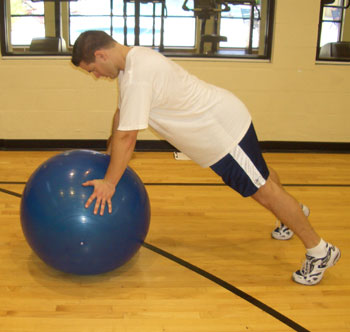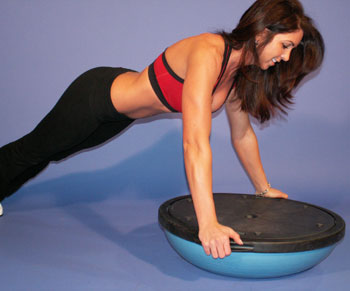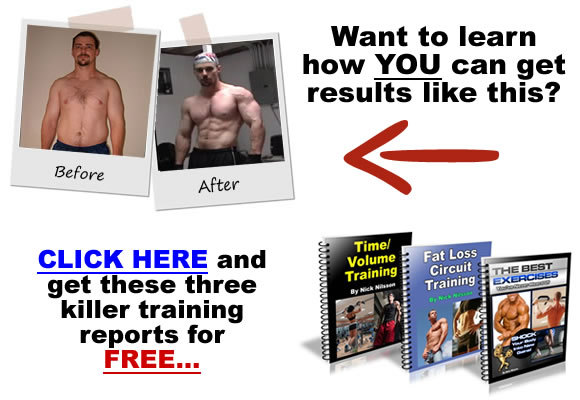|
Unstable And Proud Of It!
Learn How To Turn The Ordinary Push-Up Into An Exercise "In Stability"
When I get finished teaching you this never-before-seen version of the push-up, you're going to think that either I'm crazy or a genius or both! Of course, the results you'll get from it will speak for themselves.
First, we need to set the stage for this version of the push-up.
 To begin with, exercises that move your body rather than the weight (such as the push-up) have been shown to fire more muscle fibers than exercises that move the weight rather than your body (such as the bench press). This means that the push-up has the potential to activate a lot of muscle fibers.
To begin with, exercises that move your body rather than the weight (such as the push-up) have been shown to fire more muscle fibers than exercises that move the weight rather than your body (such as the bench press). This means that the push-up has the potential to activate a lot of muscle fibers.
Next, we know that exercising in an unstable environment also increases muscle fiber activation. This is because your body compensates for the instability by firing more muscle fibers in order to stabilize the resistance. Anyone who's run barefoot on sand knows the tremendous work your calves get from it. The same concept is put to work in this exercise.
* NOTE: Effective exercise requires progression, and that is essential for learning to perform this exercise safely. Because you will end up doing it in a very unstable environment, you need to start slowly and work your way into it. Naturally, if you're an advanced trainer or are used to working in an unstable environment you may progress more quickly.
Only go as far as you're comfortable with these exercise stages. Each stage holds great benefits but you should always err on the side of caution.
Read through these exercise stages one at a time, then, at the end of the article, you'll find a link where you can view pictures of each stage.
Stage 1 - Dumbell Push-Ups
Set two dumbells on the floor in the approximate hand position and spacing you would use for a push-up. You will essentially be using the dumbells as push-up handles.
The plates on the dumbell should be round (meaning that they'll roll) for maximum instability. Use fairly lightweight dumbells, e.g. 15 to 20 pounds each, so they'll move around more.
This variation by itself is an excellent exercise for beginner to intermediate trainers. You may do this variation with your knees on the floor if you've not yet developed the strength for regular, full push-ups.
Stage 2 - Swiss Ball Push-Ups
Set a large Swiss Ball (the inflatable exercise ball) on the floor where you've got some space.
Place your hands on the floor in your regular push-up position then set your legs on top of the Swiss Ball. Your shins should be on the top of the ball, placed slightly to the sides so you can use them to maintain your balance.
Do push-ups in this position. You will find that the ball will shift around as you are doing the exercise and you'll be forced to move your body around to keep your legs on top of it. The ball will roll slightly forward with you as you drop down to the bottom of the push-up position and roll slightly back as you push yourself up.
Stage 3 - Swiss Ball/Dumbell Push-Ups
Now that you've experienced instability at both ends of the push-up, it's time to put them both together and feel the burn!
 Be sure you are comfortable with other two progressions before attempting this one and be sure you are not too close to anything should you lose your balance and roll off.
Be sure you are comfortable with other two progressions before attempting this one and be sure you are not too close to anything should you lose your balance and roll off.
Set the dumbells up as you did in Stage 1 and set the ball up as you did in Stage 2. Place your hands on the dumbells first then set your legs on the ball.
Now do push-ups on three rolling, unstable surfaces!
Make sure you drop down and get a full range of motion (the dumbell handles will allow you to go further down than if you were doing them on the floor).
The first few reps may feel easy but as you continue, you will notice a burning sensation in the deep muscle fibers of your chest. Keep going! This is where it gets good. You are now hitting muscle fibers that have most likely never been effectively worked by standard chest exercises!
And if you think you're getting a burn on the first set, just wait till you do a few more sets. You'll feel it across your abs and sides too!
The reason this exercise is so effective is simple: complete instability.
Since the vast majority of chest exercises are performed in a reasonably stable position, there are some muscle fibers that never get fully worked. They aren't required to work because you're stabilized.
By placing your legs and both hands on independently moving objects, you demand massive amounts of stabilizing work on the part of your pecs. Your pecs never normally get this work with most chest exercises. Now they're stabilizing your entire body and your limbs while you're moving yourself up and down!
All this intense stabilizing work fires many more muscle fibers than are normally required for a push-up, resulting in a tremendously effective exercise for the chest.

More Articles by Author Nick Nilsson
Return To Weight Lifting Articles Archive
|